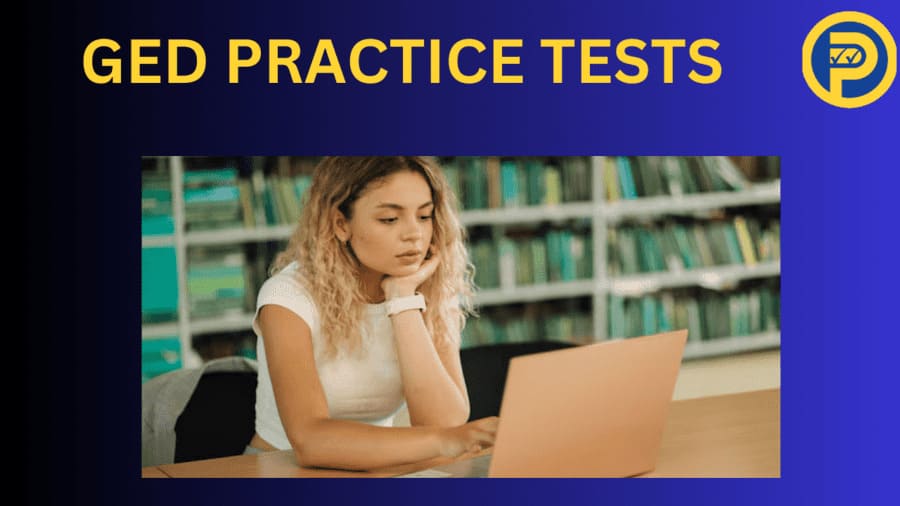Taking the first step toward earning your GED can feel overwhelming, but guess what? You’ve got this! And we’re here to make sure you’re fully prepared. One of the best ways to set yourself up for success is with a GED Practice Test. Practice tests are like the ultimate cheat code (without the cheating!) for passing your GED.
Prepsaret offers the best online GED practice test questions, tailored to give you a real edge. Let’s dive into why they’re so awesome and how they can help you crush your goals.
What is a GED Practice Test?
A GED Practice Test is a simulation of the actual GED test that allows you to practice answering similar questions under test-like conditions.
These tests cover the same subjects as the GED exam, helping you prepare for the big day with confidence. It’s a hands-on way to identify what you know, what you don’t, and how to ace every section.
Find out: How Hard is the GED Test?
GED Test Sections Overview
The GED test is divided into four main sections, each designed to test different skills. Let’s break them down:
Mathematical Reasoning
This section covers everything from basic arithmetic to algebra and geometry. Expect questions that involve problem-solving, data interpretation, and reasoning.
Whether it’s calculating percentages or solving equations, this section ensures you’re comfortable with real-world math scenarios.
Discover: How to Pass the GED Math Test
Reasoning Through Language Arts
Here’s your chance to show off your reading and writing skills. This section includes reading comprehension, grammar, and even essay writing. It’s about understanding texts, identifying arguments, and expressing your thoughts clearly in writing.
Science
From life sciences to physical sciences, this section tests your ability to interpret data, apply scientific concepts, and think critically. You don’t need to memorize a ton of facts, but you do need to understand key principles and how to apply them.
Social Studies
Think history, government, economics, earth, space science and geography. This section evaluates your ability to analyze information, interpret graphs and charts, and think critically about social and historical topics.
Free GED Practice Tests
- GED Math Test (No-Calculator)
- GED Science Test
- GED Math Test (Calculator)
- GED Social Studies Test
- GED Language Arts Test
GED Extended Response Practice
- GED Essay Sample Response
- GED Essay Writing Guide
- GED Essay Practice Question
Benefits of Taking GED Practice Tests
- Assessing Your Current Knowledge Level: Practice tests reveal your strengths and areas for improvement, giving you a clear starting point.
- Familiarizing Yourself with the Test Format: Get comfortable with the types of questions and the test layout to avoid surprises on exam day.
- Identifying Strengths and Weaknesses: Pinpoint the topics you’ve mastered and the ones that need more focus.
- Reducing Test Anxiety Through Practice: The more you practice, the more confident and relaxed you’ll feel during the actual test.
Types of GED Practice Tests
- Full-Length Practice Tests: Simulate the entire GED experience by taking a practice test that covers all sections.
- Section-Specific Practice Tests: Focus on one subject at a time to dive deep and master individual sections.
- Timed vs. Untimed Practice Tests: Timed tests help you manage pacing, while untimed ones let you focus on accuracy and understanding.
Where to Find Free GED Practice Tests Online
If you’re looking for reliable, comprehensive, and free GED practice tests, look no further than our GED Test Prep. With over 150 free GED practice test questions and answers, it’s your go-to resource for top-notch prep.
Tips for Choosing the Right Practice Test for Your Needs
- Pick tests aligned with the GED format.
- Look for detailed explanations for correct answers.
- Choose platforms like Prepsaret that offer a mix of question types.
How to Use GED Practice Tests Effectively
- Setting a Study Schedule and Goals: Plan your practice sessions and set achievable milestones.
- Simulating Real Test Conditions: Take practice tests in a quiet space with no distractions to mimic exam conditions.
- Reviewing Incorrect Answers and Learning from Mistakes: Analyze where you went wrong and focus your studies on those areas.
- Combining Practice Tests with Study Guides: Use study guides to strengthen weak areas identified in your practice tests.
GED Practice Test Tips and Strategies
- Managing Your Time During the Practice Test: Allocate time wisely to ensure you answer all questions.
- Staying Focused and Avoiding Distractions: Create a test-like environment and eliminate interruptions.
- Techniques for Answering Multiple-Choice Questions: Read all options carefully, eliminate wrong answers, and make educated guesses if needed.
Related post: Top 10 GED Study Tips

Free GED Practice Questions by Subject
Mathematical Reasoning
Question:
Edward has $70 to spend on utility bills each month. The basic monthly charge for sewer and water is $31.89. Electricity costs $0.1118 for each kilowatt hour used, x. The inequality 0.1118 x + 31.89 ≤ 70 represents Edward’s monthly utility budget. To the nearest kilowatt-hour, how many kilowatt hours of electricity can Edward use without exceeding his monthly utility budget?
- 118
- 341
- 247
- 413
Solution:
Formula to be used: Linear inequalities formula: ax + b ≤ c:
To get the number of kilowatt hours of electricity that Edward can consume without exceeding his monthly utility bill, we have to solve the inequality 0.1118 x + 31.89 ≤ 70 using the formula
[ax + b ≤ c]:
0.1118 x + 31.89 ≤ 70
Subtracting 31.89 from each side;
0.1118x ≤ 70-31.89
0.1118x ≤ 38.11
Dividing each side by 0.1118 we get:
x ≤ 340.89
Therefore;
To the nearest kilowatt-hour:
x ≤ 341
Therefore, choice B is the correct answer.
Reasoning Through Language Arts
Read the passage below and answer the question.
Passage:
The small town of Greendale was buzzing with excitement as preparations for the annual harvest festival began. Each year, the festival brought together farmers, artisans, and visitors to celebrate the season’s bounty. Amid the cheerful hustle, Mayor Allen reminded everyone that the festival was not just about fun—it was also an opportunity to give back to the community.
Question:
What is the primary purpose of the passage?
A. To emphasize the importance of community events
B. To describe how the town of Greendale was founded
- To explain how the harvest festival supports farmers
D. To persuade people to attend the harvest festival
Explanation:
The correct answer is: A. To emphasize the importance of community events
The passage highlights the excitement and collaborative spirit of the festival, as well as the mayor’s reminder about its deeper purpose—community giving. While other choices mention related ideas, the primary focus is to underscore the festival’s role in bringing the community together.
Science
Question:
A musician wanted to build a soundproof room in which to practice and record music. The musician hypothesized that dense materials would block the most sound, so he made a small box for testing potential soundproofing materials. He chose six materials to test. He conducted five trials for each material, using a decibel detector to record sound from inside the box and outside the box.
His results are shown in the table.
Which statement describes a solution for the error in the investigation?
- More trials should be performed.
- More materials should be tested.
- The box should be larger.
- The materials should be the same thickness.
Explanation:
The correct answer is D. The materials should be the same thickness.
The musician tested materials of varying thicknesses, which introduces an error. Thickness affects soundproofing effectiveness independently of density. To isolate the variable of density and accurately test the hypothesis, all materials must be of equal thickness, ensuring that the density is the only variable influencing noise reduction.
Social Studies
Question:
Which of the following best explains the purpose of the U.S. Constitution?
- To establish state-level laws and regulations
B. To provide a framework for the federal government and protect individual rights
C. To create economic policies for the nation
D. To outline international treaties and alliances
Explanation:
The correct answer is: B. To provide a framework for the federal government and protect individual rights
The U.S. Constitution establishes the structure of the federal government (legislative, executive, and judicial branches) and outlines checks and balances to limit power. It also protects individual rights through amendments, such as the Bill of Rights. It is a guiding document ensuring a balance of governance and liberty in the U.S. system.
Additional Resources for GED Preparation
- GED Study Guides and Books: Comprehensive materials for in-depth learning.
- GED Prep Courses: Online or offline options tailored to your learning style.
- Support Groups and Forums: Connect with others on the same journey.
FAQs About the GED Practice Test
Are Online GED Practice Tests as Effective as In-Person Resources?
Yes! Online tests like those on Prepsaret are convenient and just as effective.
How Often Should I Take a Practice Test?
Take one week to track your progress and adjust your study plan.
What is the Passing Score for the GED?
The passing score is 145 on each subject.
How Many Questions Are on the GED Test?
Approximately 35-50 questions per section. Most are multiple choice but there are other formats such as fill in the blank and drag and drop.
Can I Retake the GED Test if I Fail?
Absolutely! GED Testing Service allows you to retake the GED tests multiple times, depending on your state’s policies.
GED Practice Test: Your Pathway to Success
Your GED journey starts with preparation; a GED Practice Test is your secret weapon for success. So, why wait? Head over to Prepsaret and start practicing today. You’re just one step away from earning your high school diploma and unlocking a brighter future. Ready to ace it? Let’s go!

